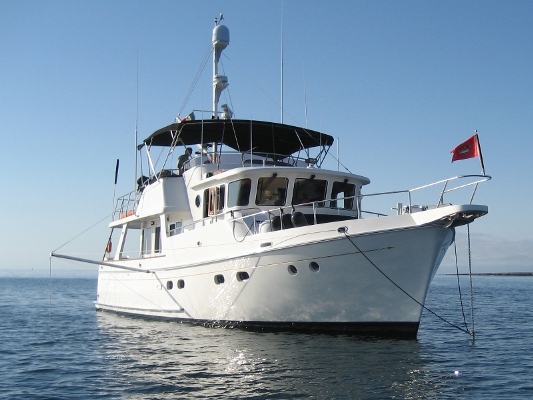


 |
 |
 |
|||
|
|
|||||
| Stabilizing A Selene at Anchor | ||||

By: John & Kathy Youngblood
So what are flopper stoppers and why did we install them on Mystic Moon? "Flopper Stopper" is the generic term for products that attenuate wave action at anchor - minimize the rolling. They are often referred to as roll stabilizers or anti-roll devices. The system consists of a fin deployed about 15 feet underwater, suspended either by an outrigger pole or from a boom to get the fin away from the side of the boat; a topping lift to take the competing stresses as the boat wants to roll and the fin tries to prevent it; an aft and fore guy line to keep the boom in place; and a fin retrieval line to help you pull the fin back up when it's time to go. You want to keep the fin that deep so that it will stay under water as you roll. We never needed these units while cruising in the Pacific Northwest because the anchorages there are relatively well protected from swells and wind chop. We installed flopper stoppers on the advice of many cruisers who have anchored along the Pacific west coast, specifically in Southern California and Mexico. Most of these anchorages are exposed to the ocean swells and can be quite rolly. Recently we cruised the Channel Islands and Catalina off of Southern California before we had the flopper stoppers installed and quickly understood what our fellow cruisers had been telling us. Once moored at Two Harbors on Catalina, we were consistently rolling 10 to 15 degrees, as though we were underway in some moderate seas. We had 2 -3 foot swells hitting just off our stern and sometimes on our beam. We had to stow everthing as if we were underway. The next morning, Val and Stan Creighton of Pax Nautica, with whom we were buddy boating, informed us that night was one of the smoother and more peaceful nights they'd experienced. We placed our order for flopper stoppers the next day.
We chose to use the 8 foot spinnaker pole arrangement on the starboard side, as we have had issues with the mast in the past and did not want to have any more loads on the mast and rigging than necessary. You can choose a longer pole, but the 8 foot pole is about all we can comfortably handle while deploying or stowing. We used a fin produced by Prime Fabrication that measures 42" X 28.5" and weighs 34 pounds. A link to their web site is included at the end of this article. The aft guy line runs to the stern hawsehole and the fore guy runs to the bow hawsehole. The topping lift padeye is located on the forward edge of the FB combing, just forward of the BBQ cabinets. The topping lift line is made of 1/4" spectra line. We had a canvas bag made for the fin, as it does fold in half for storing but is quite bulky and unwieldy to handle, so the bag helps for handling and storing. It also is convenient for storage of all lines and parts for the flopper stopper system. We store the boom in two mast chocks (Forespar Model MPC 300) over the Salon windows on the starboard side-deck. The clips keep the boom, which weighs about ten pounds, very secure, yet readily available for deployment. For the port side, we purchased a smaller Magma fin that measures 36" X 21" and weighs 18 pounds, which we will rig with the mast and boom. Our boom extends about 3 feet from the Flybridge deck, so we are hoping that a smaller fin deployed about 15 feet underwater will not stress the mast and rigging and the fin will be deployed deep and far enough away to not strike the hull. Those with full walk around decks usually opt for a matched pair of the 8 foot booms.
Kevin at Outbound Yachts, the company that has outfitted most of the Selenes in Dana Point, CA, installed our flopper stoppers, and he did an excellent job. For more information on the fins we purchased, see the following web sites: |
||||
 
| ||||
| Copyright (c) MDT Consulting, LLC 2007. All rights reserved. | Visit the Selene manufacturer's web site | Use & Privacy Policy | Contact us | |